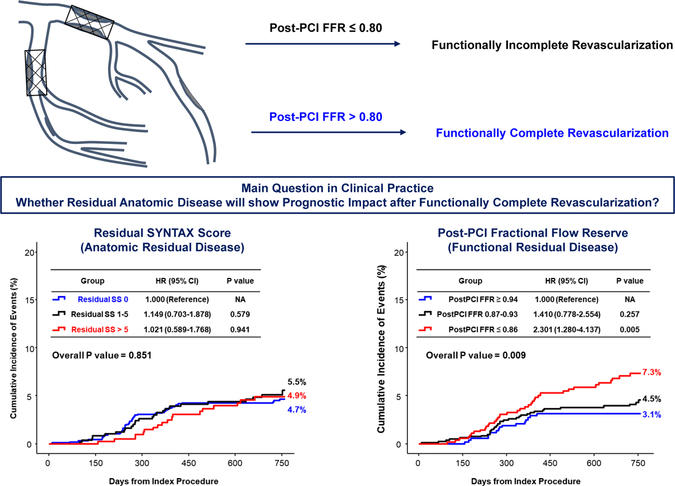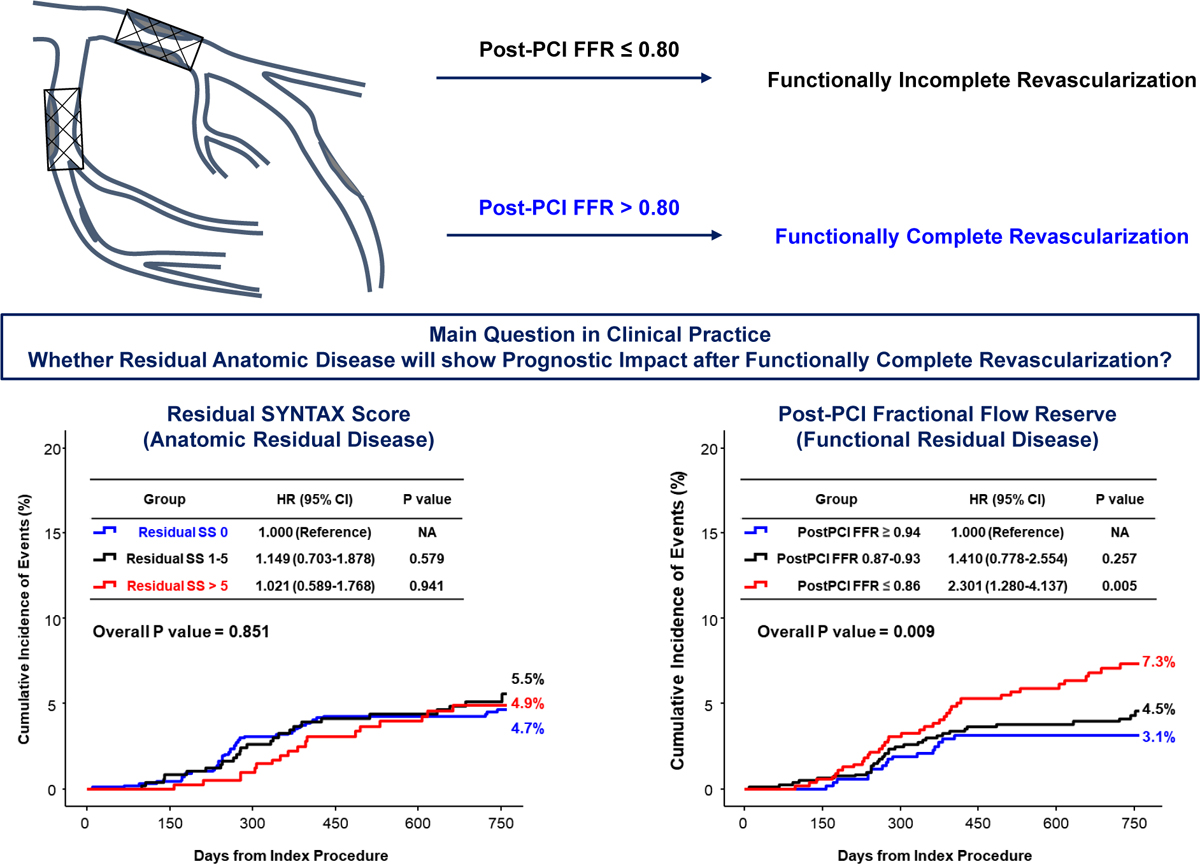Prognostic impact of residual anatomic disease burden after functionally complete revascularization
Selected in Circulation Cardiovascular Interventions by N. Ryan
This registry-based study evaluated the clinical outcomes of patients who underwent functionally complete revascularisation as assessed by post PCI FFR >0.80 at two years according to Residual Syntax Scores.
References
Authors
Joo Myung Lee, Doyeon Hwang, Ki Hong Choi, Hyun-Jong Lee, Young Bin Song, Yun-Kyeong Cho, Chang-Wook Nam, Joo-Yong Hahn, Eun-Seok Shin, Joon-Hyung Doh, Masahiro Hoshino, Rikuta Hamaya, Yoshihisa Kanaji, Tadashi Murai, Jun-Jie Zhang, Fei Ye, Xiaobo Li, Zhen Ge, Shao-Liang Chen, Tsunekazu Kakuta, Bon-Kwon Koo
Reference
Circ Cardiovasc Interv . 2020 Sep;13(9):e009232
Published
September 2020
Link
Read the abstractReviewer
My Comment
Why this study? – the rationale/objective
This registry-based study evaluated the clinical outcomes of patients who underwent functionally complete revascularisation as assessed by post PCI FFR >0.80 at two years according to Residual Syntax Scores.
The role of physiology guided revascularisation in optimising patient outcomes has been well recognised. Similarly, the Residual Syntax Score (RSS) has been shown to have an important prognostic effect including in studies where revascularisation was based on functional assessment. To date, there is no data looking at the role of the RSS in patients with functionally complete revascularisation based on post PCI physiology measurements.
How was it executed? – the methodology
This study used data from the International Post-PCI FFR Registry comprising four prospective studies; DKCRUSH VII, 3V-FFR-FRIENDS, COE-PERSPECTIVE and the institutional registry of Tsuchiura Kyodo General Hospital.
- The primary endpoint was TVF (a composite of cardiac death, target vessel MI, or clinically driven TLR) at 2 years.
- The risk of TVF was compared across tertiles of RSS (0, 1-5, >5) and tertiles of post PCI FFR (≤0.86, 0.87-0.93, ≥ 0.94)
What is the main result?
The registry was composed of 2,425 vessels in 2,228 patients, of which 2,095 vessels in 1,910 patients with a post PCI FFR >0.8 were included in this study. Median follow up was 760 days (IQR 702-760). The population was composed mainly of men in their 60’s with a typical cardiovascular risk factor profile.
- TVF at two years was 4.9% in the group as a whole with no differences in RSS in patients with or without TVF (3.5±5.0 vs. 3.5±5.1, p=0.969)
- There was a significantly higher pre PCI Syntax Score (16.2±8.2 vs. 11.7±7.1, p<0.001) and lower pre (0.67±0.12 vs. 0.70±0.12, p=0.047) and post PCI FFR (0.88±0.05 vs. 0.90±0.05, p=0.002) in the TVF group.
- When classified by tertile of RSS there was no difference in incidence of TVF at two years (log-rank p=0.851)
- Patients with a lower post PCI FFR ≤0.86 had a higher risk of TVF compared to the highest tertile of post PCI FFR ≥ 0.94 (7.3% vs. 3.1%, HR 2.301, 95%CI 1.280-4.137, p=0.005)
- At multivariate analysis post PCI FFR was an independent predicator of TVF whilst RSS was not.

Critical reading and the relevance for clinical practice
The results of this study show that in patients who undergo functionally complete revascularisation, using post PCI FFR to determine the completeness of revascularisation, the RSS does not appear to be prognostically important, this is at odds with previous studies where the RSS had prognostic importance. However, this study demonstrated that even with a post PCI FFR is >0.8 the post PCI FFR value does appear to predict TVF. This suggests that assessing a stented lesion with FFR and targeting further intervention to obtain as high as possible a post PCI FFR may have prognostic implications for the patient.
A note of caution when interpreting the results, one must bear in mind that this study was based on retrospective registry data with its inherent limitations. Based on pre-PCI SYNTAX Scores the overall complexity of disease was low and therefore the generalisability to more severe disease needs assessment.
In summary, this registry suggests that post PCI FFR may be an important predictor of long term outcomes however it’s value needs to be assessed in large prospective trials.





No comments yet!